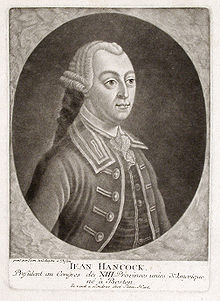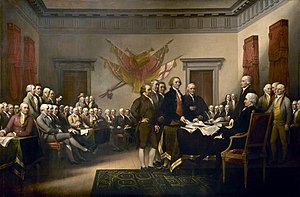This is an old revision of this page, as edited by Gwernol (talk | contribs) at 15:41, 21 November 2006 (Reverted edits by 208.58.177.214 (talk) to last version by AntiVandalBot). The present address (URL) is a permanent link to this revision, which may differ significantly from the current revision.
Revision as of 15:41, 21 November 2006 by Gwernol (talk | contribs) (Reverted edits by 208.58.177.214 (talk) to last version by AntiVandalBot)(diff) ← Previous revision | Latest revision (diff) | Newer revision → (diff) For other people named John Hancock, see John Hancock (disambiguation).| John Hancock | |
|---|---|
 | |
| 1st and 3rd Governor of Massachusetts | |
| In office 1780 – 1785 May 30, 1787 – October 8, 1793 | |
| Lieutenant | Thomas Cushing |
| Preceded by | None |
| Succeeded by | Thomas Cushing (1785), Samuel Adams (1787) |
| Personal details | |
| Born | January 12 1737 Quincy, Massachusetts |
| Died | October 8 1793 Quincy, Massachusetts |
| Political party | None |
| Spouse | Dorothy Quincy |
John Hancock (January 12, 1737 (O.S.) – October 8, 1793 (N.S.)) was President of the Second Continental Congress and of the Congress of the Confederation; first Governor of Massachusetts; and the first person to sign the United States Declaration of Independence.
Children
John and Dorothy had two children, neither of whom survived to adulthood.
- Lydia Hancock (Oct 1776–Aug 1777); died at the age of about ten months.
- John George Washington Hancock (21 May 1778–27 January 1787); died at the age of eight years.
Early career

A Boston selectman and representative to the Massachusetts General Court, his colonial trade business naturally disposed him to resist the Stamp Act, which attempted to restrict colonial trading.
The Stamp Act was repealed, but later acts (such as the Townshend Acts) led to further taxation on common goods. Eventually, Hancock's shipping practices became more evasive, and he began to smuggle glass, lead, paper and tea. In 1768, upon arriving from England, his sloop Liberty was impounded by British customs officials for violation of revenue laws. This caused a riot among some infuriated Bostonians, depending as they did on the supplies on board.
His regular merchant trade as well as his smuggling practices financed much of his region's resistance to British authority and his financial contributions led the people of Boston to joke that "Sam Adams writes the letters and John Hancock pays the postage" (Fradin & McCurdy, 2002).
American Revolution

At first only a financier of the growing rebellion, he later became a public critic of British rule. On March 5, 1774, the fourth anniversary of the Boston Massacre, he gave a speech strongly condemning the British. In the same year, he was unanimously elected president of the Provisional Congress of Massachusetts, and presided over its Committee of Safety. Under Hancock, Massachusetts raised bands of "minutemen"—soldiers who pledged to be ready for battle in a minute's notice—and his boycott of tea imported by the British East India Company eventually led to the Boston Tea Party.
In April 1775 as the British intent became apparent, Hancock and Samuel Adams slipped away from Boston to elude capture, staying in the Hancock-Clarke House in Lexington, Massachusetts (which can still be seen to this day). There Paul Revere roused them about midnight before the British troops arrived at dawn for the Battle of Lexington and Concord. At this time, General Thomas Gage ordered Hancock and Adams arrested for treason. Following the battle a proclamation was issued granting a general pardon to all who would demonstrate loyalty to the crown—with the exceptions of Hancock and Adams. On May 24, 1775, he was elected the third President of the Second Continental Congress, succeeding Peyton Randolph. He would serve until October 30, 1777, when he was himself succeeded by Henry Laurens.
In the first month of his presidency, on June 19, 1775, Hancock commissioned George Washington commander-in-chief of the Continental Army. A year later, Hancock sent Washington a copy of the July 4, 1776 congressional resolution calling for independence as well as a copy of the Declaration of Independence.

Hancock was the only one to sign the Declaration of Independence on the fourth; the other 55 delegates signed on August 2nd. He also requested Washington have the Declaration read to the Continental Army. According to popular legend, he signed his name largely and clearly to be sure King George III could read it without his spectacles, causing his name to become an eponym for "signature". However, other examples suggest that Hancock always wrote his signature this way.
From 1780–1785, he was governor of Massachusetts. Hancock's skills as orator and moderator were much admired, but during the American Revolution he was most often sought out for his ability to raise funds and supplies for American troops. Despite his skill in the merchant trade, even Hancock had trouble meeting the Continental Congress's demand for beef cattle to feed the hungry army. On January 19, 1781, General Washington warned Hancock:
"I should not trouble your Excellency, with such reiterated applications on the score of supplies, if any objects less than the safety of these Posts on this River, and indeed the existence of the Army, were at stake. By the enclosed Extracts of a Letter, of Yesterday, from Major Genl. Heath, you will see our present situation, and future prospects. If therefore the supply of Beef Cattle demanded by the requisitions of Congress from Your State, is not regularly forwarded to the Army, I cannot consider myself as responsible for the maintenance of the Garrisons below West Point, New York, or the continuance of a single Regiment in the Field." (United States Library of Congress, 1781.)
Quotes
- “In circumstances as dark as these, it becomes us, as Men and Christians, to reflect that whilst every prudent measure should be taken to ward off the impending judgments, …at the same time all confidence must be withheld from the means we use; and reposed only on that God rules in the armies of Heaven, and without His whole blessing, the best human counsels are but foolishness… Resolved; …Thursday the 11th of May…to humble themselves before God under the heavy judgments felt and feared, to confess the sins that have deserved them, to implore the Forgiveness of all our transgressions, and a spirit of repentance and reformation …and a Blessing on the … Union of the American Colonies in Defense of their Rights …That the people of Great Britain and their rulers may have their eyes opened to discern the things that shall make for the peace of the nation…for the redress of America’s many grievances, the restoration of all her invaded liberties, and their security to the latest generations."
Day of Fasting, Humiliation and Prayer, with a total abstinence from labor and recreation. Proclamation on April 15, 1775
Additional notes
In 1772, Poems on Various Subjects, Religious and Moral was published. John Hancock was among those who signed the attestation that Phillis Wheatley, an African American, was its author, refuting the popular assertion that a black woman could not have the intellect to produce the work. When, in 1773, the book was put on display in Aldgate, London (having been refused by Boston publishers) it thus became the first book by an African American to be officially published. He made his signature big enough so that King George 111 didn't have to use his glasses.
He was also a Freemason.
As Governor of Commonwealth of Massachusetts he presented a flag to the Bucks of America black military unit of Boston. See Prince Hall Freemasonry.
Things named after John Hancock
A number of things have been named after John Hancock:
- Several states named a Hancock County after him. They are: Georgia, Illinois, Indiana, Iowa, Kentucky, Maine, Mississippi, Ohio, Tennessee, and West Virginia.
- The town of Hancock, Massachusetts is named in his honor
- John Hancock Insurance, a U.S. insurance company, and in turn its office buildings,
- The John Hancock Tower, the tallest building in Boston, Massachusetts
- The "Old" John Hancock building, also in Boston, Massachusetts
- The John Hancock Center, major skyscraper in Chicago
- Continental schooner Hancock, hired to support George Washington's siege of Boston from 1775-1776
- Continental Navy frigate Hancock, one of the first 13 frigates authorized by the Second Continental Congress in 1775. Served in 1777 until captured by the British.
- USS Hancock (AP-3), the former steamer SS Arizona, served as a Navy transport from 1902 to 1925
- USS John Hancock, an 1850 steam tug
- USS Hancock (CV-19), an aircraft carrier that served from 1944 to 1976, including service in both World War II and the Vietnam War
- USS John Hancock (DD-981), a Spruance class destroyer commissioned in 1979 and decommissioned in 2000
- The college football John Hancock Bowl, played in El Paso, Texas between 1990 and 1993.
- The John Hancock Student Village at Boston University, a 10-acre dormitory and recreational complex sponsored by John Hancock Insurance
References
- Fradin, Dennis Brindell & McCurdy, Michael (2002). The Signers: The 56 Stories behind the Declaration of Independence. Walker & Company. ISBN 0-80-278850-5.
- United States Library of Congress (1781). George Washington Papers. Online: .
- United States Library of Congress. U.S. Library of Congress Today in History: January 12. Retrieved January 18, 2003. Most of the initial text of this article was copied from this public domain source.
External links
- United States Congress. "John Hancock (id: H000149)". Biographical Directory of the United States Congress.
- Biography by Charles A. Goodrich, 1856
- Massachusetts Governor Biography
| Political offices | ||
|---|---|---|
| Preceded byPeyton Randolph | President of the Second Continental Congress May 24, 1775 – October 31, 1777 |
Succeeded byHenry Laurens |
| Preceded byThomas Gage (Provincial governor) |
Governor of Massachusetts 1780 – 1785 |
Succeeded byThomas Cushing |
| Preceded byRichard Henry Lee | President of the United States in Congress Assembled November 23, 1785 – May 29, 1786 |
Succeeded byNathaniel Gorham |
| Preceded byJames Bowdoin | Governor of Massachusetts May 30, 1787 – October 8, 1793 |
Succeeded bySamuel Adams |
